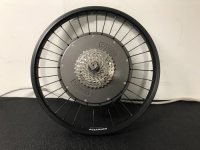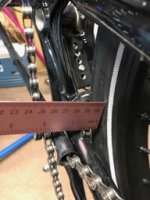rberger
10 W
My spokes started pinging the other day when the trike was under load, so I got a park sw-3 spoke wrench and tightened up my spokes based on trying to make them sound the same. But I have no idea if they really are the same. The pinging did stop though when trike was under load.
My winter project is going to be properly dishing (or undishing I still not sure which is which but I got to move the rim about 5mm away from the drive side) my rear wheel on my trike to actually be centered in the rear fork and make sure its all nice and true. Dishing/Truing a wheel is one of the last of my fears of DIY on the trike. Figured its time to get over it.
I picked up the park TM-1 Spoke tension meter but discovered that the width of the tool is bigger than the total length of the exposed spoke on the 20" rim radially laced to a crystallite 3540. They are VERY short spokes. The Wheel was built by Grin Tech and uses what seem to be high quality Sapiem Strong spokes. It wouldn't even fit in the normal front 20" wheels ether due to the cross pattern of the spokes on the front wheel. So sending it back.

So I'm wondering:
My winter project is going to be properly dishing (or undishing I still not sure which is which but I got to move the rim about 5mm away from the drive side) my rear wheel on my trike to actually be centered in the rear fork and make sure its all nice and true. Dishing/Truing a wheel is one of the last of my fears of DIY on the trike. Figured its time to get over it.
I picked up the park TM-1 Spoke tension meter but discovered that the width of the tool is bigger than the total length of the exposed spoke on the 20" rim radially laced to a crystallite 3540. They are VERY short spokes. The Wheel was built by Grin Tech and uses what seem to be high quality Sapiem Strong spokes. It wouldn't even fit in the normal front 20" wheels ether due to the cross pattern of the spokes on the front wheel. So sending it back.

So I'm wondering:
- Is there a spoke tension meter that would fit (probably can't be wider than about 60mm or so) and not cost too much (ie < $100)?
- Can such short spokes withstand being dished 5mm without over stressing them?
- Is there anything else I should be concerned about or be considering?



